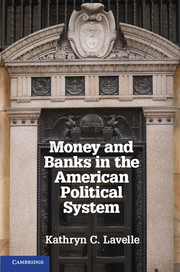Book contents
- Frontmatter
- Contents
- Figures and Tables
- Preface
- Acknowledgments
- Abbreviations
- 1 The Institutional Foundations of Financial Politics in the United States
- Section 1 A Historical Background
- Section 2 Bureaucratic Politics and Finance
- Section 3 The Operation of the Financial Political Economy
- 7 The Process in Motion
- 8 The Process Approaches Collapse
- 9 The Process in Its International Context
- Section 4 Conclusions
- Glossary
- References
- Index
- References
7 - The Process in Motion
Political Institutions, Money, and the Business Cycle
Published online by Cambridge University Press: 05 January 2013
- Frontmatter
- Contents
- Figures and Tables
- Preface
- Acknowledgments
- Abbreviations
- 1 The Institutional Foundations of Financial Politics in the United States
- Section 1 A Historical Background
- Section 2 Bureaucratic Politics and Finance
- Section 3 The Operation of the Financial Political Economy
- 7 The Process in Motion
- 8 The Process Approaches Collapse
- 9 The Process in Its International Context
- Section 4 Conclusions
- Glossary
- References
- Index
- References
Summary
Although previous chapters have considered them separately, Congress, the president and executive branch organizations, and the Federal Reserve all operate in an environment that responds to what is going on in the macroeconomy. Their response has political and economic stakes. For politicians, the ultimate censure for poor performance in an economic downturn is to lose office. For organizations such as the Office of Thrift Supervision (OTS) or Federal Deposit Insurance Corporation (FDIC), it is to lose governing authority, budget, or personnel, and ultimately to be disbanded. For the Federal Reserve, it is to lose its independence from the political institutions that created it. As the United States has opened up to the broader world economy and financial markets have grown, each of these actors has had to respond to the new challenges posed by a new environment where voters expect them to do more, and where they actually have less under their control.
This chapter considers the politics attached to fluctuations in the business cycle to uncover the day-to-day expectations that political constituencies have for individual politicians and organizations as the economy expands and contracts. It begins with a discussion of what the business cycle is, how economists have measured it, and how different schools of economic thought have attempted to provide solutions to mitigate its effects. The next section considers public policy in a recession and a recovery, as politicians attempt to translate these economic solutions into a practical government program of action. The effects of previous economic interventions often inform thinking and institutional direction going forward. The historical review offered in Chapter 2 ended with the initial moves toward deregulation in the Depository Institutions Deregulation and Monetary Control Act of 1980 and the Garn–St. Germain Depository Institutions Act in 1982. It continued in Chapter 4 with the discussion of the passage of the Financial Services Modernization Act in 1999. The third section in this chapter picks up the deregulation story and considers what the recession of 2001 and its aftermath reveal about how monetary, fiscal, and regulatory policies were reshaped among the legislature, presidential administrations, Federal Reserve, and agencies of the federal government in the wake of such major legislation.
- Type
- Chapter
- Information
- Money and Banks in the American Political System , pp. 165 - 186Publisher: Cambridge University PressPrint publication year: 2013

